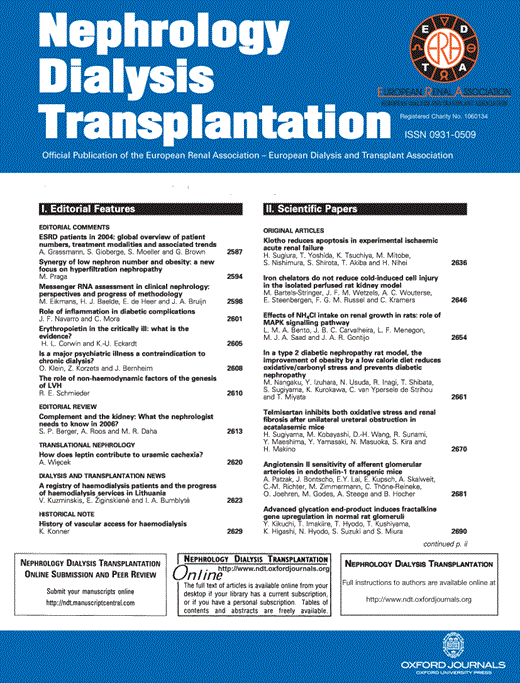-
PDF
- Split View
-
Views
-
Cite
Cite
Anna Saurina, Albert Botey, Manel Solé, Manel Vera, Mónica Pou, Albert Torras, Alejandro Darnell, Henoch–Schönlein purpura nephritis associated with coagulase‐negative staphylococci sepsis in a patient with myeloma, Nephrology Dialysis Transplantation, Volume 16, Issue 12, December 2001, Pages 2441–2442, https://doi.org/10.1093/ndt/16.12.2441
Close - Share Icon Share
Sir,
Henoch–Schönlein purpura (HSP) is a systemic vasculitis characterized by the tissue deposition of IgA containing immune complexes [1]. The pathogenesis of this disorder may be similar to that of IgA nephropathy, which is associated with identical histological findings in the kidney. Environmental agents reported to be associated with the pathogenesis of HSP nephritis include bacterial antigens, drugs, vaccinations, and also excessive alcohol intake [2,3]. We describe a case in whom HSP developed in the context of coagulase‐negative staphylococci (CNS) sepsis subsequent to a ‘port‐a‐cath’ insertion (permanent intravenous catheter). The patient was, in addition, affected by myeloma.
Case.
We present a 72‐year‐old male with a history of hypertension, in whom a Bence Jones (kappa) myeloma was diagnosed 6 months before the occurrence of acute renal failure: (creatinine 5.2 mg/dl), macrohaematuria and proteinuria of 10.2 g/24 h. Bone marrow examination showed 85% of plasma cells, and the proteinogram a monoclonal band. Renal biopsy demonstrated a myeloma kidney with atrophic tubules, eosinophilic intraluminal casts and numerous multinucleated giant cells within tubule walls and in the interstitium. Immunofluorescence was negative. A treatment with vincristine, adriamycine and dexamethasone (VAD) was started and 10 sessions of plasmapheresis were performed. The patient also needed dialysis, but after 13 sessions his renal function improved, his creatinine level being 1.9 mg/dl when he left the hospital. Three days before hospital admittance, the patient presented with high fever (38.6°C), chills and arthromyalgias. At physical examination his blood pressure was 160/80 mmHg and pulse rate 80 beats/min. His consciousness was clear. No abnormalities were present at cardiac, lung and abdominal examination. Minimal oedema with palpable purpura was noted in lower extremities and buttocks. Urinalysis showed proteinuria 10.4 g/day and sediments contained macrohaematuria. White cell count was 8.7×109/l with 66.3% neutrophils and 4% band forms, haematocrit 31%, platelet count 254×109/l. Serum total protein and albumin were 44 g/l and 26 g/l, respectively, serum creatinine 4.9 mg/dl, and BUN 59 mg/dl. Serum alkaline phosphatases, aminotransferases, bilirubin and coagulation rate were normal. Antinuclear antibodies, serum complement components, cryoglobulins and rheumatoid factor were negative or normal. Circulating inmunocomplexes were normal and the serum level of immunoglobulins was: IgA 1.160 g/l (NR: 0.7–3.12 g/l), IgM <2 g/l (NR: 0.56–3.52 g/l), and IgG <0.21 g/l (NR: 6.39–13.49 g/l). Chest X‐ray showed no infiltrates; abdominal X‐ray was normal. Blood cultures (4/4) revealed coagulase‐negative staphylococci even though a treatment with vancomycin had been started. Because he carried a permanent i.v. catheter for chemotherapy, we decided to remove this foreign body. Its culture was also positive for CNS. Subsequently, the blood cultures became negative. A skin biopsy showed leukocytoclastic vasculitis, with positive immunofluorescence for cutaneous IgA, C3 and fibrinogen deposits. A repeat kidney biopsy showed marked diffuse hypercellularity with polymorphonuclear cells and crescent formation in 25% of the glomeruli. In the insterstitium, there were large areas of fibrosis with inflammatory infiltrates and tubular atrophy. Immunofluorescence showed IgA deposits (+++) in about 50% of the glomeruli, with small amounts of C3 and fibrinogen.
Although with vancomycin treatment the fever disappeared and blood cultures became negative, the purpura of the lower extremities and buttocks spread to the rest of the body, and renal failure worsened. We made an attempt with prednisone therapy (1 mg/kg/day), with no response. The patient then developed oligoanuria and needed intermittent haemodialysis treatment.
Comment.
Nephropathies may occur in association with infectious agents but also with other environmental agents. In our patient with CNS sepsis, the almost simultaneous development of vasculitic purpura with IgA deposits in dermal vessels and glomerulonephritis with mesangial IgA and fibrinogen deposition was diagnostic of HSP.
HSP is a systemic vasculitis that is considered to be a hypersensitivity vasculitis along with two other disorders, namely mixed cryoglobulinaemia, and hypersensitivity vasculitis itself [1]. The aetiological agent of HSP is often unknown, but in many cases the syndrome follows an upper respiratory tract infection, suggesting that the precipitating antigen may be infective, and sometimes it follows a drug treatment such as penicillin [4]. The clinical manifestations include a classic tetrad that can occur in any order and any time over a period of several weeks: rash, arthralgias, abdominal pain, and renal disease [5]. The rash is typically purpuric and distributed symmetrically over the lower legs and arms. It is characterized by tissue IgA deposition containing immune complexes. The renal disease, which appears within a few days to 4 weeks after the onset of systemic symptoms [5], can be associated with mild sediment abnormalities and a normal, or only slightly elevated, plasma creatinine. Sometimes more severe signs may be present, including the nephrotic syndrome, hypertension, and acute renal failure. However, HSP must be distinguished in adults from other systemic autoimmune diseases. Confirmation of the diagnosis requires evidence of tissue deposition of IgA, in skin or kidney, by immunofluorescent microscopy. Performance of a renal biopsy is generally recommended because the degree of crescent formation is the best indicator of prognosis.
In our case, HSP appeared after a CNS sepsis in a patient with myeloma who had previously been treated with VAD. As HSP is a syndrome with an immunological basis, we postulate that the treatment of myeloma with the subsequent CNS sepsis may have been the trigger precipitating an adverse immune response.
References
Kauffmann RH, Hermann WA, Meyer CJ, Daha WA, Van Es LA. Circulating IgA‐immune complexes in Henoch–Schönlein purpura. A longitudinal study of their relationship to disease activity and vascular deposition of IgA.
Kuster S, Andrassy K, Waldherr R, Ritz E. Contrasting clinical course of Henoch–Schönlein purpura in younger and elderly patients.
Ballard HS, Eisinger RP, Gallo G. Renal manifestations of the Henoch–Schönlein syndrome in adults.





Comments